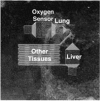Optical oxygen sensors for applications in microfluidic cell culture
- PMID: 22163408
- PMCID: PMC3230974
- DOI: 10.3390/s101009286
Optical oxygen sensors for applications in microfluidic cell culture
Abstract
The presence and concentration of oxygen in biological systems has a large impact on the behavior and viability of many types of cells, including the differentiation of stem cells or the growth of tumor cells. As a result, the integration of oxygen sensors within cell culture environments presents a powerful tool for quantifying the effects of oxygen concentrations on cell behavior, cell viability, and drug effectiveness. Because microfluidic cell culture environments are a promising alternative to traditional cell culture platforms, there is recent interest in integrating oxygen-sensing mechanisms with microfluidics for cell culture applications. Optical, luminescence-based oxygen sensors, in particular, show great promise in their ability to be integrated with microfluidics and cell culture systems. These sensors can be highly sensitive and do not consume oxygen or generate toxic byproducts in their sensing process. This paper presents a review of previously proposed optical oxygen sensor types, materials and formats most applicable to microfluidic cell culture, and analyzes their suitability for this and other in vitro applications.
Keywords: cell culture; lab-on-a-chip; luminescence; microfluidics; optical oxygen sensors.
Figures







Similar articles
-
Immunoassays in microfluidic systems.Anal Bioanal Chem. 2010 Jun;397(3):991-1007. doi: 10.1007/s00216-010-3678-8. Epub 2010 Apr 27. Anal Bioanal Chem. 2010. PMID: 20422163 Review.
-
Optical glucose sensor for microfluidic cell culture systems.Biosens Bioelectron. 2023 Oct 1;237:115491. doi: 10.1016/j.bios.2023.115491. Epub 2023 Jun 25. Biosens Bioelectron. 2023. PMID: 37413826
-
[Microfluidic cell culture array chip for drug screening assays].Sheng Wu Gong Cheng Xue Bao. 2009 May;25(5):779-85. Sheng Wu Gong Cheng Xue Bao. 2009. PMID: 19670650 Chinese.
-
Fast pesticide detection inside microfluidic device with integrated optical pH, oxygen sensors and algal fluorescence.Biosens Bioelectron. 2017 Feb 15;88:188-195. doi: 10.1016/j.bios.2016.08.014. Epub 2016 Aug 5. Biosens Bioelectron. 2017. PMID: 27523821
-
[Research progress of integrating electrical impedance sensors with microfluidic chips in cell detection].Sheng Wu Gong Cheng Xue Bao. 2024 Jun 25;40(6):1792-1805. doi: 10.13345/j.cjb.230668. Sheng Wu Gong Cheng Xue Bao. 2024. PMID: 38914492 Review. Chinese.
Cited by
-
A Miniature Intermittent-Flow Respirometry System with a 3D-Printed, Palm-Sized Zebrafish Treadmill for Measuring Rest and Activity Metabolic Rates.Sensors (Basel). 2020 Sep 7;20(18):5088. doi: 10.3390/s20185088. Sensors (Basel). 2020. PMID: 32906794 Free PMC article.
-
Smart Cell Culture Systems: Integration of Sensors and Actuators into Microphysiological Systems.ACS Chem Biol. 2018 Jul 20;13(7):1767-1784. doi: 10.1021/acschembio.7b01029. Epub 2018 Feb 15. ACS Chem Biol. 2018. PMID: 29381325 Free PMC article. Review.
-
Biomimetic tumor microenvironment on a microfluidic platform.Biomicrofluidics. 2013 Jan 7;7(1):11501. doi: 10.1063/1.4774070. Biomicrofluidics. 2013. PMID: 24396521 Free PMC article. Review.
-
A Comprehensive Review of Organ-on-a-Chip Technology and Its Applications.Biosensors (Basel). 2024 May 1;14(5):225. doi: 10.3390/bios14050225. Biosensors (Basel). 2024. PMID: 38785699 Free PMC article. Review.
-
Luminescent sensing and imaging of oxygen: fierce competition to the Clark electrode.Bioessays. 2015 Aug;37(8):921-8. doi: 10.1002/bies.201500002. Epub 2015 Jun 25. Bioessays. 2015. PMID: 26113255 Free PMC article. Review.
References
-
- Bunn HF, Poyton RO. Oxygen sensing and molecular adaptation to hypoxia. Physiol. Rev. 1996;76:839–885. - PubMed
-
- Ivanovic Z. Hypoxia or in situ normoxia: The stem cell paradigm. J. Cell Physiol. 2009;219:271–275. - PubMed
-
- Goligorsky MS. Making sense out of oxygen sensor. Circ. Res. 2000;86:824–826. - PubMed
-
- Lahiri S. Historical perspectives of cellular oxygen sensing and responses to hypoxia. J. Appl. Physiol. 2000;88:1467–1473. - PubMed
-
- Hockel M, Vaupel P. Tumor hypoxia: definitions and current clinical, biologic, and molecular aspects. J. Nat. Cancer Inst. 2001;93:266–276. - PubMed
Publication types
MeSH terms
Substances
LinkOut - more resources
Full Text Sources
Other Literature Sources
Research Materials
Miscellaneous

